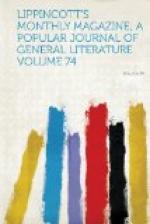has not yet arrived, to roam up and down the dark
passages, to the increase of the general dirt and
discomfort. In this connection it may be well
to enter a protest against the Munich regulation,
or absence of regulation, which allows every butcher
to slaughter pigs, calves and sheep upon his own premises.
To say nothing of the shocking sights and sounds which
are thereby forced upon the attention of the dwellers
in the neighborhood of such shops, it is impossible,
considering the defective drainage and insufficient
water supply, that the practice should not be of serious
injury to the public health. There are also many
cellars which are rented out entirely to fruiterers
and green-grocers not living in the buildings as a
place to store their goods for the winter. In
such cases the cellars are apt to remain in a filthy
condition, and the smells that pour from the windows
are at once a nuisance to passers-by and a source
of danger to the inhabitants of the houses. But
it is not only the living inhabitants of Munich that
are corrupting the heavens above, the earth beneath
and the waters under the earth: the dead in their
graves are busy at the same work. It is a pity
that all thinking persons who still object to the
practice of cremation as unnecessary and impious could
not be compelled to take up their residence for a
while in the neighborhood of the two great cemeteries
of Munich: they would not be long in crying out
for the adoption of purifying flames and the innoxious
columbarium.
The Old (or Southern) Cemetery at the time of its
first enclosure was a short distance outside of the
city, though not so far as it ought to have been;
but by degrees the streets have been extended to its
very walls, and property-owners build without hesitation
handsome dwelling houses whose windows look directly
down upon that field of corruption, piously denominated
“God’s Acre.” The New Cemetery,
on the north side of the town, has been in use only
five or six years, and was from the beginning but
a block or two removed from the nearest houses.
The air in the vicinity of the Old Cemetery is so
laden with the smell of death that even the natives
are aware of it, while strangers generally avoid a
second visit. It is a rule that every seven years
a portion of the ground occupied by rented graves
shall be dug over for new tenants, the partially decayed
remains found therein being brought together and buried
again in an indiscriminate heap. This method is
about as bad as it could be, but the graves that are
left undisturbed are not much less harmful to the
living. These can be leased for a period of seventy
years, the lease to be renewed if desired, but never
for a longer term than seventy years without renewal.
Whole generations of families are thus buried together,
each grave being dug deep enough to hold several coffins
one above another, the last one coming to within a
few feet of the surface. Now, when one considers
the nature of the soil, the closeness of the cemetery




